|
|
Introduction: Body condition refers to the relative amount of subcutaneous body fat or energy reserve in the cow. Wildman et. al. developed a 5-point (1 to 5) scoring system to measure the relative amount of this subcutaneous body fat. Most body condition scoring (BCS) systems in dairy cattle use the 5-point scoring system with quarter point increments. Body condition scoring of dairy cattle is an important management tool for maximizing milk production and reproductive efficiency while reducing the incidence of metabolic and other peripartum diseases.
Over-conditioning at the time of calving (BCS > 4.0) often results in reduced feed intake and increased incidence of peripartum problems. Under-conditioning at calving (BCS < 3.0) often results in lower peak milk yield and less milk for the entire lactation. Also cows should not lose more than 1.0 body score during early lactation. Excessive loss of body condition in early lactation has been shown to reduce reproductive efficiency.
Dr. James Ferguson and coworkers at the University of Pennsylvania have developed an organized process for BCS dairy cows. This system utilizes a method which directs the scorer to view certain anatomical sites of the pelvic and loin area. Use of this system helps develop consistency and repeatability in BCS. This system concentrates its accuracy toward the mid scores (2.5 to 4.0) which include most cows. The mid-range BCS are also the most critical for making management decisions. Scores above or below this range indicate significant problems. Exact scoring of extremes in BCS are less critical. While the majority of cows conform to the described criteria, a few cows may not fit exactly. The final BCS may need to be adjusted based upon consideration of observations from all designated areas. Also realize that using the quarter point system, many cows will fall between two scores (i.e., 2.75 and 3.0). Under those circumstances the scorer will need to make a judgment as to the closest score. Quarter point differences in scores are not significant under most circumstances.
The first described step in the system is to determine if the line from the hook bone, to the thurl, to the pin bone is angular (V) or crescent (U). This step is often the most difficult of the scoring process, especially if the cow is near the 3.0 or 3.25 score. If uncertain of a V or U proceed to the next step. View the cow from the rear. Observe the amount of padding over the hook and pin bones and the prominence of the tailhead and sacral ligaments. From this point the scorer can usually determine the appropriate score. When a BCS has been determined, the scorer should continue the evaluation process at least an additional step to confirm the final score.
Anatomical areas used in this system are identified below:
All of the following pictures, text, and sound have been used by permission from Elanco Animal Health.
| Click for sound |
|
| Click for sound |
|
____________________________________________________________________
First, view the pelvic area from the side. Check the line from the hooks, to the thurl, to the pins.
| Click for sound |
|
If the line forms a flattened V, then consider a BCS of less than or equal
to 3.0. Proceed to figures #1-4. If the line forms a crescent or flattened U, consider a BCS of greater
than or equal to 3.25. Proceed to figures #5-8.
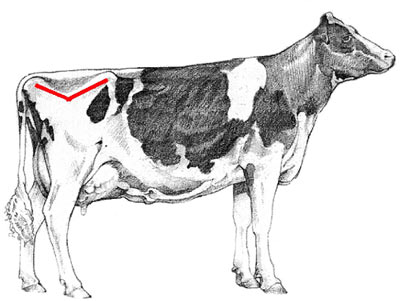
If the line forms a flattened V, then consider a BCS of less than or equal to 3.0.
| Click for sound |
|
____________________________________________________________________

Figure #1: If the hooks are rounded, then assign a BCS of 3.0.
| Click for sound |
|
____________________________________________________________________
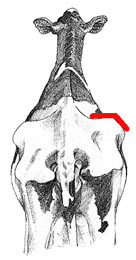
Figure #2: If the hooks are angular, the cow has a BCS of less than or equal to 2.75. If the pins are padded, assign a BCS of 2.75.
| Click for sound |
|
____________________________________________________________________
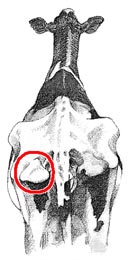
Figure #3: If the pins are angular, then the cow has a BCS of less than 2.75. If there is a palpable fat pad on the point of the pins, then assign a BCS of 2.50.
| Click for sound |
|
____________________________________________________________________

Figure #4: If there is no fat pad on the pins, the cow has a BCS of less than 2.50. Look for corrugations along the top of the short ribs as the fat covering disappears. If corrugations are visible 1/2 of the way from the tip of the short ribs to the spine, then assign a BCS of 2.25. If corrugations are visible 3/4 of the way from the tip of the short ribs to the spine, then assign a BCS of 2.0. If the thurl is prominent and the cow has a saw-toothed spine, assign a BCS of less than 2.0.
| Click for sound |
|
____________________________________________________________________
| Click for sound |
|
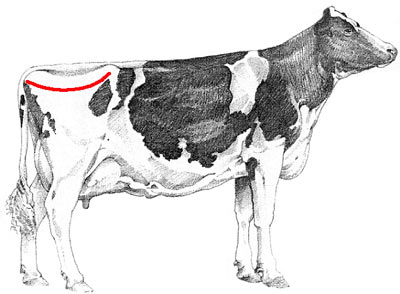
If the line forms a crescent or flattened U, consider a BCS of greater than or equal to 3.25. Proceed to figures #5-8.
____________________________________________________________________
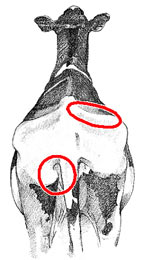
Figure #5: If the sacral and tailhead ligaments are visible, assign a BCS of 3.25.
| Click for sound |
|
____________________________________________________________________
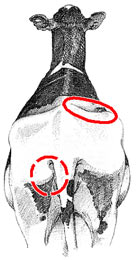
Figure #6: If the sacral ligament is visible and the tailhead ligament is barely visable, assign a BCS of 3.50.
| Click for sound |
|
____________________________________________________________________
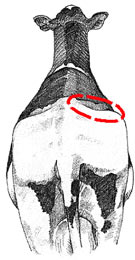
Figure #7: If the sacral ligament is barely visible and the tailhead ligament is not visable, assign a BCS of 3.75. If the sacral and tailhead ligaments are not visable, the cow has a BCS of greater than or equal to 4.00.
| Click for sound |
|
____________________________________________________________________
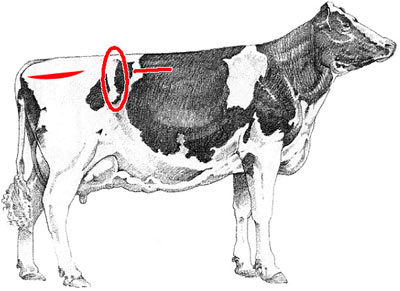
Figure #8: If the thurl is flat, the cow has a BCS of greater than 4.00. If the tips of the short ribs are barely visable, assign a BCS of 4.25. If the thurl is flat and the pins are buried, assign a BCS of 4.5. If the hooks are barely visable, assign a BCS of 4.75. If all boney prominences (hooks, pins, etc.) are well rounded, assign a BCS of 5.0.
| Click for sound |
|